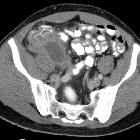neutropenic enterocolitis


Typhlitis, also called cecitis or neutropenic colitis, is a necrotizing inflammatory condition which typically involves the cecum and, sometimes, can extend into the ascending colon, appendix or terminal ileum.
Epidemiology
Typhlitis was first described in children with leukemia and severe neutropenia (seen with an absolute neutrophil count < 1000 per microliter). It most commonly occurs in immunocompromised patients, chemotherapy and steroid therapy patients including:
- leukemia (most common)
- lymphoma
- aplastic anemia
- AIDS
- solid organ transplant
Clinical presentation
Clinically, patients with typhlitis present with a mixture of localized and systemic symptoms including a fever, chills, nausea, vomiting, diarrhea, abdominal pain, tenderness and a distended abdomen. Peritoneal irritation and occult bloody stools may be present. Pain in the right lower quadrant may mimic appendicitis.
Pathology
The condition is characterized by intramural bacterial invasion without an inflammatory reaction. This then leads to edematous thickening and induration of the cecal wall or other mural segments of the colon and distal small bowel.
The exact cause is unknown but is believed due to a combination of ischemia, infection (especially with cytomegalovirus, Pseudomonas aeruginosa), mucosal hemorrhage, and perhaps neoplastic infiltration .
Radiographic features
Plain radiograph
Plain film findings are often non-specific. May show evidence of a small bowel obstruction (SBO), soft-tissue mass in the right lower quadrant, thumbprinting due to bowel wall edema intramural gas or bowel wall thickening.
Ultrasound
Transabdominal ultrasonography demonstrating bowel wall thickening in an appropriate clinical context has been used to supplement the clinical diagnosis of typhlitis. Bowel wall thickening may be eccentric or concentric and is often dramatic; cecal wall measurements are often above 1 cm in severe cases. Sonographic findings are relatively non-specific, but are especially helpful in high pretest probability patients, and may also address the possibility of cholecystitis which, especially in the immunocompromised, have an atypical presentation .
Bowel wall thickening >4 mm is virtually always demonstrated; other features consistent with the diagnosis include:
- preferential involvement of terminal ileum, cecum, and ascending colon
- involved segments often demonstrate luminal distension with hypoechoic fluid
- increased echogenicity of peri-cecal fat
- localized hypokinesis/akinesis of involved bowel loops, with otherwise preserved motility
- hypoechogenicity of the thickened bowel wall
- haustral folds in involved colonic segments are usually preserved
- color flow interrogation of involved bowel demonstrates preservation of bowel wall perfusion
- characteristic echogenic thickening of the mucosa has been reported in some pediatric reports
Computed tomography should always supplement sonographic evaluation of typhlitis, especially for occult complications including intra-abdominal abscess and bowel perforation.
CT
This is often the imaging modality of choice in patients suspected of having typhlitis in view of high risks of perforation during colonoscopy or during a barium enema .
CT may demonstrate thickening of the cecum as well as fat stranding, pneumatosis intestinalis, bowel wall thickening and ileus. Features of small bowel obstruction may also be seen. There may be intramural areas of low attenuation which may represent hemorrhage or edema .
Serial CT may also play a role in monitoring the success of treatment .
Angiography (DSA)
Arteriography is not part of the routine assessment. The entire cecum may be hypervascular, which may be seen as intense staining of the mucosa and its folds .
Treatment and prognosis
If possible, management should be conservative with IV antibiotics, nasogastric suctioning, and bowel rest. Any delay in diagnosis may result in transmural bowel necrosis. Surgical resection may be necessary for bleeding or bowel infarction.
Differential diagnosis
For a terminal ileitis consider the differential diagnosis of a terminal ileitis.
History and etymology
Refers to "typhlós", ancient Greek word for "blind" (referring to the blind-ending cecum) .
Siehe auch:
und weiter:

 Assoziationen und Differentialdiagnosen zu neutropene Enterokolitis:
Assoziationen und Differentialdiagnosen zu neutropene Enterokolitis:




